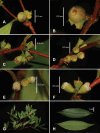Syzygiumtriflorum (Myrtaceae), a new species from Vietnam
- PMID: 40255653
- PMCID: PMC12006818
- DOI: 10.3897/phytokeys.255.143043
Syzygiumtriflorum (Myrtaceae), a new species from Vietnam
Abstract
Syzygiumtriflorum T.T.Hoang, Kim Thanh, S.Tagane & D.H.Cuong, sp. nov., from Kon Chu Rang Nature Reserve, Vietnam, is described and illustrated. The new species is distinguished from related species, Syzygiumskiophilum, by its having 4-angled and reddish-grey twigs, oblong leaves with an attenuate apex, less secondary veins of 26-30 pairs, exclusively axillary inflorescences, lanceolate-ovate bracts, sessile flowers, obconical hypanthium (slightly pyriform in flower buds) and more stamens of 18-28. The flowers and fruits were observed in the rainy season, July 2024. This new species grows under a mixed broad-leaved and coniferous forest dominated by Dacrydiumelatum and Dacrycarpusimbricatus.
Keywords: Flora; Indochina; Kon Chu Rang Nature Reserve; Myrtales.
Dang Hung Cuong, Nguyen Thi Kim Thanh, Nguyen Huu Hiep, Dang Ngoc Huyen, Thanh Truong Hoang, Shuichiro Tagane.
Conflict of interest statement
The authors have declared that no competing interests exist.
Figures



References
-
- Ahmad B, Baider C, Bernardini B, Biffin E, Brambach F, Burslem D, Byng JW, Christenhusz M, Florens FBV, Lucas E, Ray A, Ray R, Smets E, Snow N, Strijk JS, Wilson PG. (2016) Syzygium (Myrtaceae): Monographing a taxonomic giant via 22 coordinated regional revisions. PeerJ Preprints 4: 1–13. 10.7287/peerj.preprints.1930v1 - DOI
-
- Airy Shaw HK. (1949) Additions to the flora of Borneo and other Malay Islands. XX. The Myrtaceae of the Oxford University Expedition to Sarawak, 1932. Kew Bulletin 4: 117–125. 10.2307/4119049 - DOI
-
- Ashton PS. (2011) Myrtaceae. In: Soepadmo E, Saw LG, Chung RCK, Kiew R. (Eds) Tree Flora of Sabah and Sarawak, Volume 7.Sabah Forestry Department, Forest Research Institute Malaysia (FRIM), Sarawak Forestry Department, Malaysia, 87–330. 10.26525/TFSS7002 - DOI
-
- Beentje H. (2010) The Kew Plant Glossary: An Illustrated Dictionary of Plant Identification Terms. Bibliovault OAI Repository, the University of Chicago Press, 1–160.
-
- Biffin E, Craven LA, Crisp MD, Gadek PA. (2006) Molecular systematics of Syzygium and allied genera (Myrtaceae): Evidence from the chloroplast genome. Taxon 55(1): 79–94. 10.2307/25065530 - DOI
LinkOut - more resources
Full Text Sources
Miscellaneous
